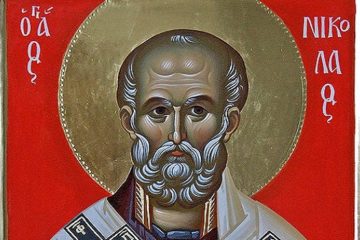Sotirios Theologou
Christ has risen.
Since last Sunday, we’ve been celebrating and honoring the great message of Christ’s resurrection. It’s a message that’s always enduring and a reminder that, however we live, however many difficulties and problems we may have, however many people are against us, Christ has risen.
We’ve come to the first Sunday after Easter and we call to mind the unbelief of Thomas as regards the risen Christ.
‘On the evening of that first day of the week, when the disciples were together, with the doors locked for fear of the Jewish leaders, Jesus came and stood among them and said, “Peace be with you”’.
The disciples rejoiced at seeing the Lord, who showed them his hands and side (the signs of the Passion). Christ says to them again: ‘Peace be with you. As the Father has sent me, I am sending you’. When he’d said this he breathed on them and said: ‘Receive the Holy Spirit. If you forgive anyone’s sins, their sins are forgiven; if you do not forgive them, they are not forgiven’.
But Thomas, known as the Twin [which is what ‘Thomas’ means in Hebrew/Aramaic] wasn’t with them at the time they saw Christ. The other disciples tried to explain that they’d seen the Lord, but Thomas replied: ‘Unless I see the nail marks in his hands and put my finger where the nails were, and put my hand into his side, I will not believe’.
Eight days later, the disciples were with Thomas in the house when Christ appeared again , even though the doors were closed. He said once more: ‘Peace be with you’, and addressing Thomas directly, said: ‘Put your finger here; see my hands. Reach out your hand and put it into my side. Stop doubting and believe’.
Thomas responded and said: ‘My Lord and my God’. Then Christ said: ‘Because you have seen me, you have believed; blessed are those who have not seen and yet have believed’.
In today’s Gospel reading, Thomas represents all of us who want to see something of Christ so that we can believe. There are not a few Christians who want to see something in order to believe in Christ’s resurrection. Despite what’s often said, Thomas wasn’t an unbeliever; he was a doubter. He couldn’t get his mind round the fact that a human being had defeated death and had risen from the grave. He felt he couldn’t rely only on the testimony of the other disciples, who had actually seen Christ; he wanted to see for himself before he believed.
And so, eight days later, Christ again appeared to his disciples and Thomas, whom he urged to touch the wounds made by the nails and the spear. And Thomas answered with: ‘My Lord and my God’.
The most obvious question is why Christ appeared several days later and not at the time when Thomas was expressing his doubts. He appeared eight days later, that is a Sunday, the day when his resurrection occurred, in order to increase Thomas’ unbelief and also to demonstrate to the other disciples that they could do nothing without him.
Today, also, Christ invites us to investigate his resurrection. He challenges those who can’t believe in the event to look in the Gospels at all those events which his disciples experienced and which prove Christ’s resurrection.
According to Saint John Chrysostom, Christ didn’t perform any miracles after the resurrection, because the resurrection was itself the greatest wonder he worked on our behalf.
The saints of our Church are also important witnesses to the resurrection. Saint George the Great Martyr and Trophy Bearer, whose feast we celebrate today gave his life in order to gain eternal life.
Let’s live Christ’s resurrection. No matter what the difficulties and problems, in the end the resurrection comes. In the end, there’s our encounter with God.
Let’s make an effort to have more than a formal relationship with God, but rather to invest in a close and meaningful one, in which he will become for each of us: ‘My God’.
Easter greetings!
Source: pemptousia.com




0 Comments